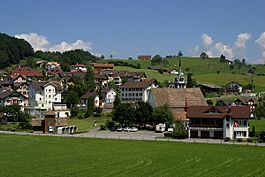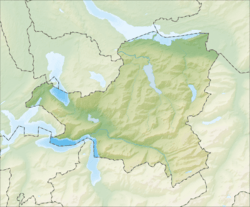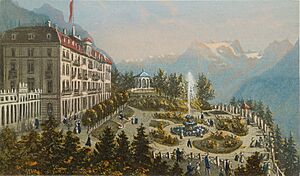Morschach facts for kids
Quick facts for kids
Morschach
|
||
|---|---|---|
 |
||
|
||
| Country | Switzerland | |
| Canton | Schwyz | |
| District | Schwyz | |
| Area | ||
| • Total | 20.84 km2 (8.05 sq mi) | |
| Elevation | 650 m (2,130 ft) | |
| Population
(Dec 2020 )
|
||
| • Total | 1,151 | |
| • Density | 55.23/km2 (143.05/sq mi) | |
| Postal code |
6443
|
|
| Surrounded by | Ingenbohl, Muotathal, Riemenstalden, Seelisberg (UR), Sisikon (UR), Schwyz | |
Morschach is a small town, also called a municipality, in the canton of Schwyz in Switzerland. It is located in the Schwyz District. Morschach was once a very famous holiday spot from 1869 until the Great Depression in the 1930s.
Geography of Morschach
This town is built on a glacier moraine, which is a hill made of rocks and dirt left behind by a glacier. It sits high above the beautiful Lake of Lucerne. Morschach includes the main village and also the popular holiday area called Stoos, which is great for both summer and winter activities.
About half of Morschach's land (52.3%) is used for farming. A large part (36.2%) is covered by forests. Only a small amount (2.9%) has buildings or roads. The rest (8.6%) is made up of things like rivers, glaciers, or mountains.
History of Morschach
Morschach was first mentioned in records in 1261. For many centuries, until 1865, a main path to the Gotthard Pass went right through the village. This path was important for travel and trade.
In 1869, a very fancy hotel called the "Grand Hotel Axenstein" opened. It was built in a spot that Queen Victoria herself once called "the most beautiful place on earth." This was because of its amazing views of Lake Lucerne and the mountains. Just four years later, another luxury hotel, the "Palace Hotel Axenfels," was built nearby.
Many famous people stayed in Morschach during their holidays. These included King Ludwig II of Bavaria, Queen Wilhelmina of the Netherlands, and even Winston Churchill. In 1905, a special train line called a rack railway was built. It connected Morschach and Axenstein to the town of Brunnen.
However, things changed with the Great Depression and World War II. Fewer people from other countries came to visit. The old hotels in Morschach never fully recovered. The "Axenfels" hotel was taken down in 1947, and the "Axenstein" in 1967. The rack railway also stopped running in 1969.
But Morschach became a major holiday spot again when the Swiss Holiday Park opened in 1982.
People of Morschach
Morschach has a population of 1,151. About 14.7% of the people living in Morschach are from other countries. Over the last 10 years, the number of people living here has grown by about 9.3%.
Most people in Morschach (89.0%) speak German. Serbo-Croatian is the second most common language (2.0%), followed by Portuguese (1.7%).
In Morschach, about 28.6% of the population is under 19 years old. About 34.6% are between 20 and 39 years old. People aged 40 to 64 make up 25.8% of the population. Older adults, aged 65 and above, make up about 11.1% of the population.
There are 305 households in Morschach. About a quarter of these (24.6%) are single-person households. About 8.9% are large households with five or more people.
In the 2007 election, the most popular political party was the SVP, which got 45.6% of the votes. The CVP was next with 26.3%.
Many adults in Morschach have finished higher education. About 57.2% of people aged 25-64 have completed either advanced high school or a university degree.
Morschach has a low unemployment rate of 1.41%. Most jobs are in the service industry (tertiary sector), like hotels and shops. There are also jobs in farming (primary sector) and manufacturing (secondary sector).
Most people in Morschach (74.1%) are Roman Catholic. About 6.8% belong to the Swiss Reformed Church. A small number of people belong to other Christian churches or are Islamic. About 6.89% of the population do not belong to any church.
The table below shows how the population of Morschach has changed over time:
| year | population |
|---|---|
| 1850 | 462 |
| 1900 | 518 |
| 1950 | 587 |
| 1980 | 632 |
| 1985 | 771 |
| 1990 | 824 |
| 2000 | 848 |
| 2005 | 893 |
| 2007 | 938 |
Images for kids
See also
 In Spanish: Morschach para niños
In Spanish: Morschach para niños








